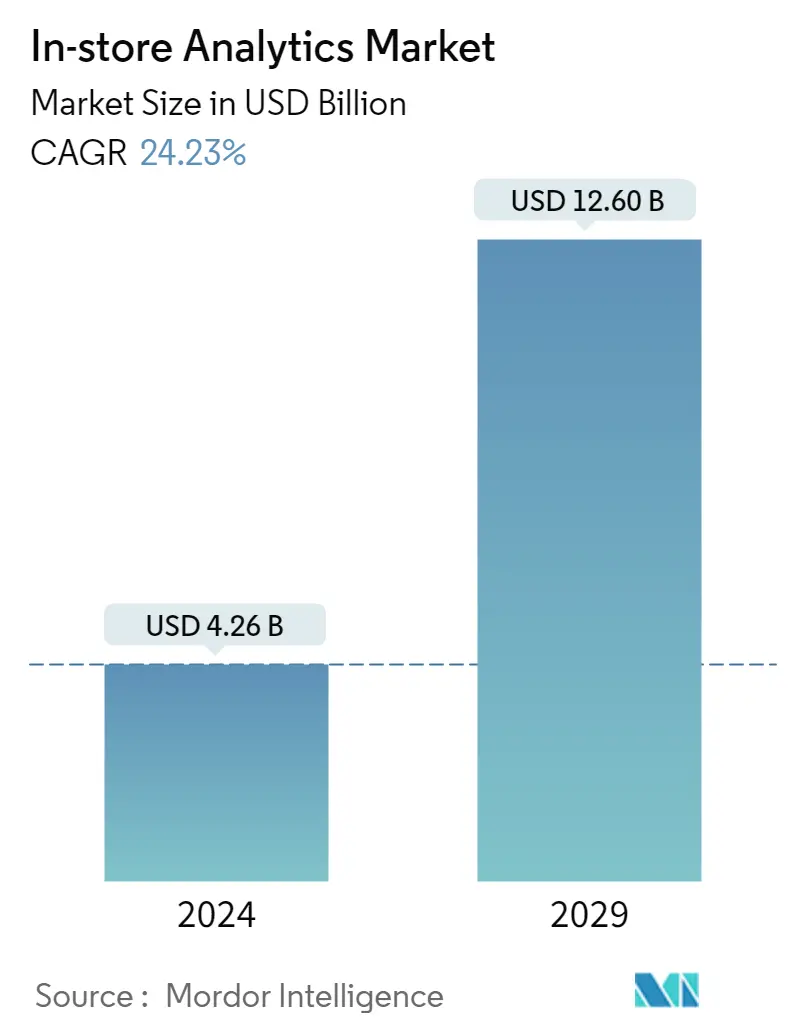Market Size of In-store Analytics Industry

| Study Period | 2019 - 2029 |
| Market Size (2024) | USD 4.26 Billion |
| Market Size (2029) | USD 12.60 Billion |
| CAGR (2024 - 2029) | 24.23 % |
| Fastest Growing Market | Asia-Pacific |
| Largest Market | North America |
Major Players
*Disclaimer: Major Players sorted in no particular order |
Instore Analytics Market Analysis
The In-store Analytics Market size is estimated at USD 4.26 billion in 2024, and is expected to reach USD 12.60 billion by 2029, growing at a CAGR of 24.23% during the forecast period (2024-2029).
Increased Competition From E-commerce Players coupled with the need for enhanced shopping and customer services has been significant contributors to the growth of the In-store Analytics Market globally.
- In-store analytics refers to analyzing customer behavior and drawing conclusions from it. This analysis focuses on the number of consumer behaviors observed when a customer visits a store. Store owners widely use it to boost their sales and improve customer satisfaction.
- Retail brands are focused on integrating cloud computing, a highly flexible and robust cloud-based reporting solution that provides a complete view of the business and empowers it to make informed decisions faster with increasing sales. The increasing advantage of the cloud further holds a strong trend in driving the in-store analytics market. According to NewGenApps, retailers leveraging the full potential of cloud computing for big data analytics can optimize their operating margins by approximately 60%. Also, the omnichannel retailer can monitor in-store customer behavior and drive timely offers to customers, thereby keeping the purchase within the fold of the retailer.
- Customer experience in in-store environments is one of the great brand differentiators which generates repeat buyers and loyal customers. It also includes everything from how the store looks and how employees engage with customers. The need for better customer service, enhanced shopping experience, and several techniques to increase sales without spending money could drive the demand for the in-store analytics market.
- However, the need for more personnel skills challenges the market's growth. The market faces a few issues owing to the need for more skilled personnel, which need to be more efficient to derive the required and vital insights from the retail data.
- Further, due to the COVID-19 pandemic, the business growth for analytics service providers is penetrating. As businesses for brick and mortar are shuttered during this pandemic, it is clear how important the cloud is for the continuity of operations. Any retail organization that actively resisted digitalization may face the harsh reality of the pandemic, which puts cloud providers in a strong position. In-store analytics also provides a platform for the supply chain distribution chain, which holds the demand for the market during the pandemic. This trend would continue to grow over the next few years due to entrant of new market players and expansion into new regions.
Instore Analytics Industry Segmentation
The In-store Analytics analyzed and pulled meaningful insights from customers' behavioral data and focused on optimizing store performance through the cloud and on-premise deployment platform, which drives the market through an application such as customer management, risk and compliance management, store operations management, merchandise management, among others.
The In-store Analytics Market is segmented by Component (Software and Services), Deployment (Cloud and On-Premises), Organization Size (Large Enterprises, Small & Medium Enterprises), Application (Customer Management, Risk and Compliance Management, Store Operations Management, Merchandise Management), and Geography (North America, Europe, Asia Pacific, Latin America, Middle East and Africa). Further, the study also covers the impact of COVID-19 on the in-store analytics market in different regions.
The market sizes and forecasts are provided in terms of value (USD million) for all the above segments.
| By Component | |
| Software | |
| Services |
| By Deployment | |
| Cloud | |
| On-Premises |
| By Organization Size | |
| Large Enterprises | |
| Small & Medium Enterprises |
| By Application | |
| Customer Management | |
| Risk and Compliance Management | |
| Store Operations Management | |
| Merchandise Management | |
| Other Applications |
| By Geography | |
| North America | |
| Europe | |
| Asia Pacific | |
| Latin America | |
| Middle East and Africa |
In-store Analytics Market Size Summary
The in-store analytics market is poised for substantial growth, driven by the increasing need for retailers to enhance customer experiences and compete with e-commerce platforms. This market involves the analysis of customer behavior within physical stores, enabling retailers to boost sales and improve customer satisfaction. The integration of cloud computing and AI technologies is a significant trend, providing retailers with robust data analytics capabilities to make informed business decisions. These technologies help in optimizing operational margins and enhancing customer engagement through timely offers and personalized experiences. Despite challenges such as the need for skilled personnel and data security concerns, the market is expected to expand as retailers recognize the value of data-driven insights in understanding consumer preferences and improving service delivery.
The North American region is anticipated to hold a significant share of the in-store analytics market due to its high concentration of technology innovators and retail corporations. The rapid adoption of advanced technologies like cloud computing and AI is driving the demand for in-store analytics solutions to enhance the shopping experience. The market is characterized by fragmentation, with numerous players continuously innovating to gain a competitive edge. Recent developments include strategic partnerships and acquisitions aimed at expanding market reach and enhancing data-driven decision-making capabilities. As retailers navigate the post-pandemic landscape, in-store analytics is expected to play a crucial role in identifying strategies to recover lost sales and capture market share by addressing evolving customer needs.
In-store Analytics Market Size - Table of Contents
-
1. MARKET DYNAMICS
-
1.1 Market Overview
-
1.2 Market Drivers
-
1.2.1 Increasing advantage of the Cloud
-
1.2.2 Need for Better Customer Service and Enhanced Shopping Experience
-
1.2.3 Customer Management Segment to Witness Significant Market Growth
-
-
1.3 Market Restraints
-
1.3.1 Lack of Personnel Skills
-
-
1.4 Industry Value Chain Analysis
-
1.5 Industry Attractiveness - Porter's Five Forces Analysis
-
1.5.1 Bargaining Power of Suppliers
-
1.5.2 Bargaining Power of Consumers
-
1.5.3 Threat of New Entrants
-
1.5.4 Threat of Substitute Products
-
1.5.5 Intensity of Competitive Rivalry
-
-
1.6 Assessment of Impact of Covid-19 on the Market
-
-
2. MARKET SEGMENTATION
-
2.1 By Component
-
2.1.1 Software
-
2.1.2 Services
-
-
2.2 By Deployment
-
2.2.1 Cloud
-
2.2.2 On-Premises
-
-
2.3 By Organization Size
-
2.3.1 Large Enterprises
-
2.3.2 Small & Medium Enterprises
-
-
2.4 By Application
-
2.4.1 Customer Management
-
2.4.2 Risk and Compliance Management
-
2.4.3 Store Operations Management
-
2.4.4 Merchandise Management
-
2.4.5 Other Applications
-
-
2.5 By Geography
-
2.5.1 North America
-
2.5.2 Europe
-
2.5.3 Asia Pacific
-
2.5.4 Latin America
-
2.5.5 Middle East and Africa
-
-
In-store Analytics Market Size FAQs
How big is the In-store Analytics Market?
The In-store Analytics Market size is expected to reach USD 4.26 billion in 2024 and grow at a CAGR of 24.23% to reach USD 12.60 billion by 2029.
What is the current In-store Analytics Market size?
In 2024, the In-store Analytics Market size is expected to reach USD 4.26 billion.

